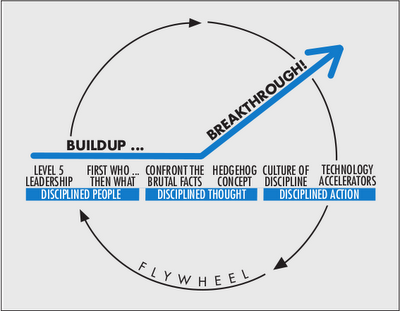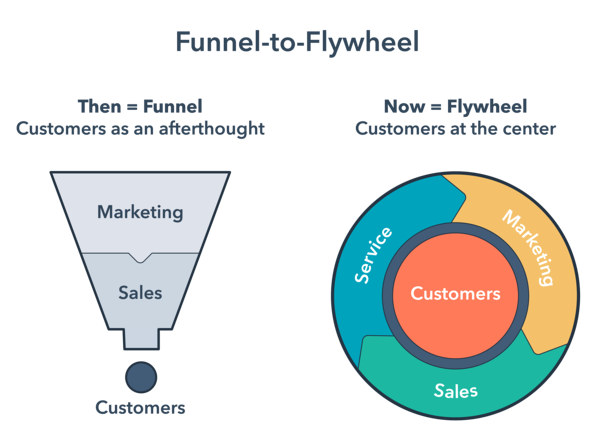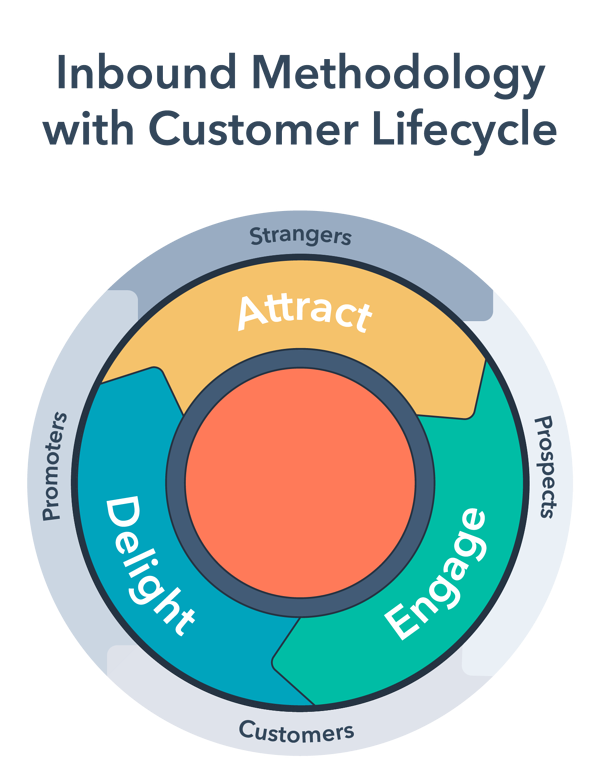At the core of any business is the relationships we have with our customers. From the first contact to recurring business and everything in between, how we engage with our customer defines their experience with us and ultimately our relationship.
To quote Simon Sinek, “People don’t buy what you do, they buy why you do it.” Nowhere is your “why” more apparent than in the way you engage with your customers throughout the customer journey.
Origin of the Flywheel
The concept of applying the flywheel to business success was introduced by Jim Collins in his book, Good to Great. Collins uses the flywheel model to describe the process of sustainable success.
Once a business defines the core elements of success in a continuum, each step builds upon and compounds the success of those before it. The more friction you’re able to remove, the more efficient the flywheel.

Source: Jim Collins
The Marketing Funnel
The traditional buyer’s journey has been described is a funnel, most commonly incorporating three core stages:
- Awareness - Discovery of your product
- Consideration - Comparison of your product to that of others
- Decision - Taking action to purchase your product
However, this approach has limitations:
- It’s focused on the sale - not the customer
- The journey ends with the one sale
- Sales and Marketing work independently of one another
Consider if we’re to apply the flywheel concept to this process. To function properly, we need to add components that will take it from a funnel to a cycle; from linear to circular. We need momentum.
HubSpot’s Flywheel
At INBOUND 2018, HubSpot CEO Brian Halligan introduced the shift from the traditional marketing and sales funnel, to a more comprehensive flywheel model.
In the flywheel, the customer is the focus, and Service is added and becomes interconnected with Marketing and Sales. Now, instead of a linear, transactional process, the buyer’s journey becomes circular.

Source: HubSpot
When we put the customer at the center, the focus is no longer on the singular sale. Instead, the focus is on our relationship with the customer, and meeting their needs before, during and after the initial sale.
 Source: HubSpot
Source: HubSpot
How the Marketing Flywheel Works
When we pull all of the elements together we remove friction and create the momentum necessary to propel the flywheel forward. Let’s take a closer look at each stage of the buyer’s journey within this context.
Awareness
During the awareness stage Service and Marketing work together to attract attention.
Providing quality service for our customers inspires not only repeat business, but also the likelihood of receiving positive reviews, backlinks to your content, and social media mentions.
Inbound marketing tactics such as optimizing your website for search, social media publishing, blogging, and email can all be used to increase visibility within your target audience.
Consideration
At this stage, Marketing and Sales present detailed content for prospects who are considering your product in comparison to other options in the marketplace. The goal is to make your product stand out among the competition.
Examples of engaging tactics and content include lead nurturing emails, case studies, podcasts, demonstrations, and free trials.
Related: Content Strategy: A Comprehensive Guide
Decision & Promotion
Once the decision to purchase has been made, the focus of Sales and Service should shift to delighting the customer. This can be achieved by providing templates, tutorials, and sales automation tools to ease the acquisition and implementation of a product.
Similarly, customer service chatbots, training manuals, online guides, and product updates provide continued value after the sale, nurturing your relationship with the customer, and increasing the likelihood of subsequent sales and their promotion of your product to others.
|
Action
|
Stage
|
Who
|
Tactics
|
Goal
|
|
Attract
|
Awareness
|
Service and Marketing
|
- Reviews
- Backlinks
- SEO
- Social Media
- Blogging
- Email
|
Strangers become prospects
|
|
Engage
|
Consideration
|
Marketing and Sales
|
- Case studies
- Templates
- Lead nurturing emails
- Podcasts
- Demos
|
Prospects become customers
|
|
Delight
|
Decision and Promotion
|
Sales and Service
|
- Sales automation
- Tutorials
- Online guides
- Service chatbots
- Product updates
|
Customers become repeat customers and promoters
|
Planning Your Flywheel
Keep it simple. Make your customers the focus by planning content that provides optimal value at each stage of their journey. This will ensure you continue to attract, engage, and delight them, resulting in a sustainable relationship between the customer and your brand.